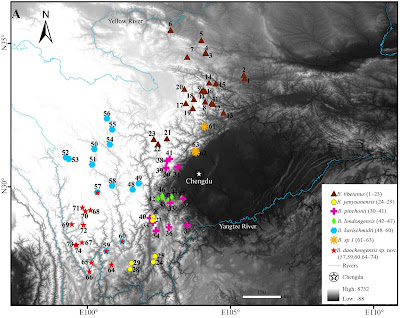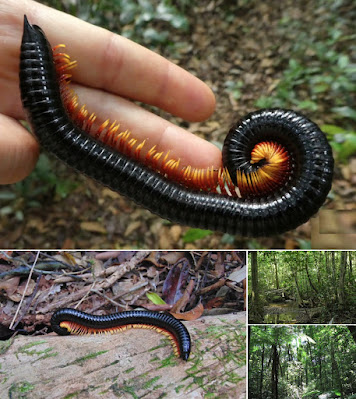[Most Recent Entries] [Calendar View]
Monday, October 26th, 2020
| Time | Event | ||||||
| 10:32a | [Entomology • 2020] Cymbalcloeon sartorii • An Incredible New Mayfly Genus (Ephemeroptera: Baetidae) from Thailand
Abstract The genus Cymbalcloeon gen. nov. (Ephemeroptera: Baetidae) is established for a new species Cymbalcloeon sartorii sp. nov. from Thailand, based on larval stage. This genus is unique among all of the Baetidae by the presence of three pairs of single gills on segments V–VII, ventrally oriented to cover the sterna VI–IX. Cymbalcloeon sartorii gen. nov. et sp. nov. presents unique or rare morphological characters such as a deeply concave margin between the prostheca and mola, without setae; a very large subtriangular process of the left mandible; a maxillary palp segment II with scarce and very long setae; almost completely fused labial palp segments II and III with numerous very long setae; elongate tarsal claw with two rows of teeth; a shagreen surface of the terga and paraproct; and a very reduced body size. The gills of the new genus move very quickly during respiration and present a near-synchronous protraction. Due to the very derived larval morphological character and the unknown imaginal stage, the exact phylogenetic position of the genus remains unclear; it most certainly belongs to the concept of Anteropatellata and is possibly closely related to the genus Baetopus.
Cymbalcloeon gen. nov. Diagnosis: Labrum (Fig 4A) rectangular, almost without distal emargination, dorsally covered with abundant setae not arranged in a row. Mandibles (Fig 4B and 4D) with margin between prostheca and mola deeply incurved, without setae; right prostheca bifid (Fig 4C). Maxilla (Fig 4G) with highly developed 2-segmented palp, long and curvate teeth at apex galea-lacinia. Labium (Fig 4H) with crescent shaped glossae and paraglossae covered with stout setae, labial palp (Fig 4I) with segments II and III almost fused, crescent shaped, covered with numerous very long, thin setae. Foreleg (Fig 5A), femur dorsally with few clavate setae, femoral patch absent; tibia with patella-tibial suture, tarsal claw elongated with two rows of denticles ending with two enlarged denticles. Hindwing pads absent. Three pairs of single gills on segments V–VI, ventrally oriented (Fig 6A). Gonostyli bud (Fig 5C) Cloeon-type. Etymology: The name of this genus is an arbitrary combination of the “Cymbal”–a musical instrument similar in appearance to the gill plate and gill mobility, and “Cloeon”–the most common and widespread genus of the subfamily. The gender is neutral. Cymbalcloeon sartorii sp. nov. Etymology: This species is dedicated to Dr. Michel Sartori (Museum of Zoology, Lausanne) for his outstanding contributions to the taxonomy of mayfly fauna worldwide and more recently in Thailand. Biological aspects: The specimens were collected at altitudes from 265 m a.s.l. to 530 m a.s.l. in two small, shallow, slow headwater streams (Fig 8). Larvae were found in sandy and pebble bottom substrates, usually together with larvae of Nigrobaetis Novikova & Kluge, 1987 and Centroptella Braasch & Soldán, 1980.
Chanaporn Suttinun, Jean-Luc Gattolliat and Boonsatien Boonsoong. 2020. Cymbalcloeon gen. nov., An Incredible New Mayfly Genus (Ephemeroptera: Baetidae) from Thailand. PLoS ONE. 15(10): e0240635. DOI: 10.1371/journal.pone.0240635 | ||||||
| 7:38p | [Herpetology • 2020] Batrachuperus daochengensis • A New Species of the Genus Batrachuperus (Urodela: Hynobiidae) from Southwestern China
Abstract A new stream salamander species, Batrachuperus daochengensis sp. nov., from southwestern China, is described herein based on morphological and molecular evidence. Molecular phylogeny derived from the mitochondrial gene together with previous nuclear data revealed that B. daochengensis sp. nov. is sister to B. yenyuanensis. The new species differs from all other species of the genus by the following combination of characters: brown horny epidermis on tips of fingers and toes absent; tubercles on palms and soles absent; costal grooves 12; dorsal brown, mottled with blackish spots; fingers 2-3-4-1 in order of decreasing length; tips of longest digits of fore- and hindlimbs largely separated by one to two costal spaces when adpressed towards each other along sides of body. The new species is currently known in the central and southern Shaluli Mountains in southwestern China. Keywords: Batrachuperus daochengensis sp. nov., Salamander, Taxonomy, Tibetan Plateau, New species Batrachuperus daochengensis sp. nov. Diagnosis: The new species of Batrachuperus differs from all other species of the genus by the following combination of characters: brown horny epidermis on tips of fingers and toes absent; tubercles on each palm and sole absent; costal grooves 12; dorsal brown, mottled with blackish spots; fingers 2-3-4-1 in order of decreasing length; tips of longest digits of fore- and hindlimbs largely separated by one to two costal spaces when adpressed towards each other along sides of body. Distribution and habitat: Batrachuperus daochengensis sp. nov. is currently known from the central and southern Shaluli Mountains (Figure 1A). The new species is an aquatic salamander adapted to cold water environments. The holotype and paratypes were found under stones of small mountain streams at elevations ranging from 4 000 m to 4 100 m a.s.l. The breeding habits of this species are not well known. Etymology: The name daochengensis is derived from the name of the county where the holotype was collected. We recommend “Daocheng Salamander” as its English common name and “稻城山溪鲵” as its Chinese common name.
Jian-Li Xiong, Wei Luo and Xiao-Mao Zeng. 2020. A New Species of the Genus Batrachuperus (Urodela: Hynobiidae) from Southwestern China. Zoological Research. 41(5); 589-594. DOI: 10.24272/j.issn.2095-8137.2020.129 | ||||||
| 11:54p | [Diplopoda • 2020] Alienostreptus bicoloripes • A Strikingly Coloured New Giant Millipede (Spirostreptida, Harpagophoridae: Rhynchoproctinae) from Vietnam has Copycat in Borneo
ABSTRACT A new giant species of the subfamily Rhynchoproctinae with strikingly bi-coloured, red-yellow legs contrasting with a black body is described: Alienostreptus bicoloripes sp. nov. from Vietnam. The new species is assigned to the genus Alienostreptus Pimvichai, Enghoff & Panha, 2010 hitherto comprising one species, A. alienus (Attems, 1936), and differing from other rhynchoproctine genera by having the femoral spine duplicated. Species of this genus share three synapomorphic characters of the subfamily, viz (1) anterior coxal fold forms deep concavity in posterior view, (2) posterior coxal fold very low, and (3) posterior coxal fold with mesal flap. A superficially very similar colourful species from Borneo, also with bi-coloured legs but clearly not belonging to Alienostreptus due to the position of ventral soft pads on male legs, is documented based on photographs. Keywords: new species, Southeast Asia, taxonomy Taxonomy Class Diplopoda Blainville-Gervais, 1844 Order Spirostreptida Brandt, 1833 Family Harpagophoridae Attems, 1909 Subfamily Rhynchoproctinae Demange, 1961 Genus Alienostreptus Pimvichai, Enghoff & Panha, 2010 Alienostreptus bicoloripes sp. nov. Diagnosis: Differs from the only other species in the genus, A. alienus, by: - larger size - straight preanal process (epiproct) - tip of anterior coxal fold (ac)forming a flattened, sickle-shaped lamella with serrate margins - canopy of anterior coxal fold (ca) with a broad, rounded lobe (in A. alienus with serrate margins) - apical part of telopodite forming a single broadly expanded sheet, in A. alienus ending in two branches - tibial spine much shorter than in A. alienus Etymology: The species epithet refers to the strikingly bi-coloured legs. Distribution: Gia Lai and Kon Tum provinces, Vietnam (Fig. 8).
Piyatida Pimvichai, Nesrine Akkari, Irina Semenyuk, Jerôme Constant and Henrik Enghoff. 2020. A Strikingly Coloured New Giant Millipede from Vietnam has Copycat in Borneo (Diplopoda, Spirostreptida, Harpagophoridae). European Journal of Taxonomy. 722(1), 1-15. DOI: 10.5852/ejt.2020.722.1129 |
| << Previous Day |
2020/10/26 [Calendar] |
Next Day >> |








